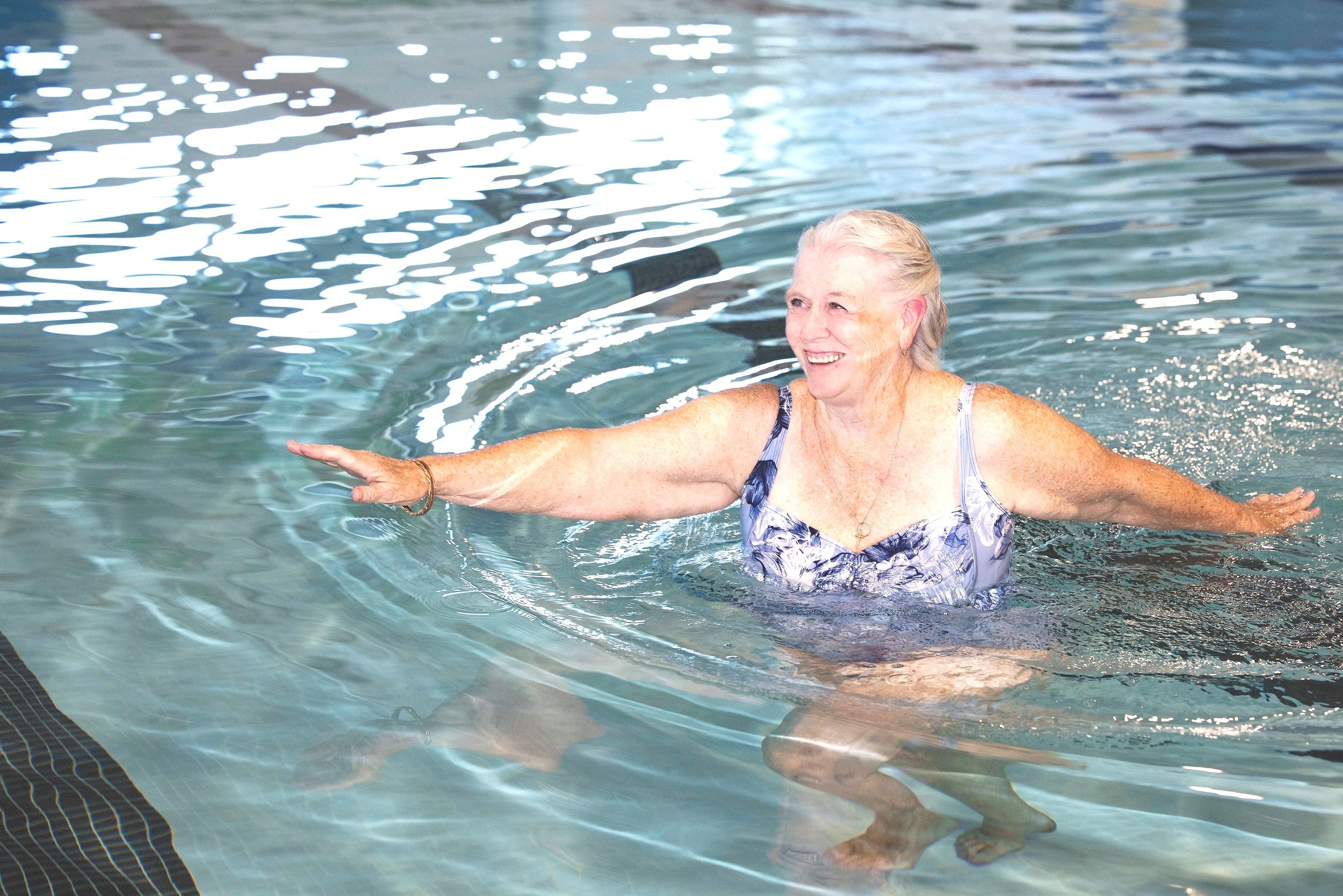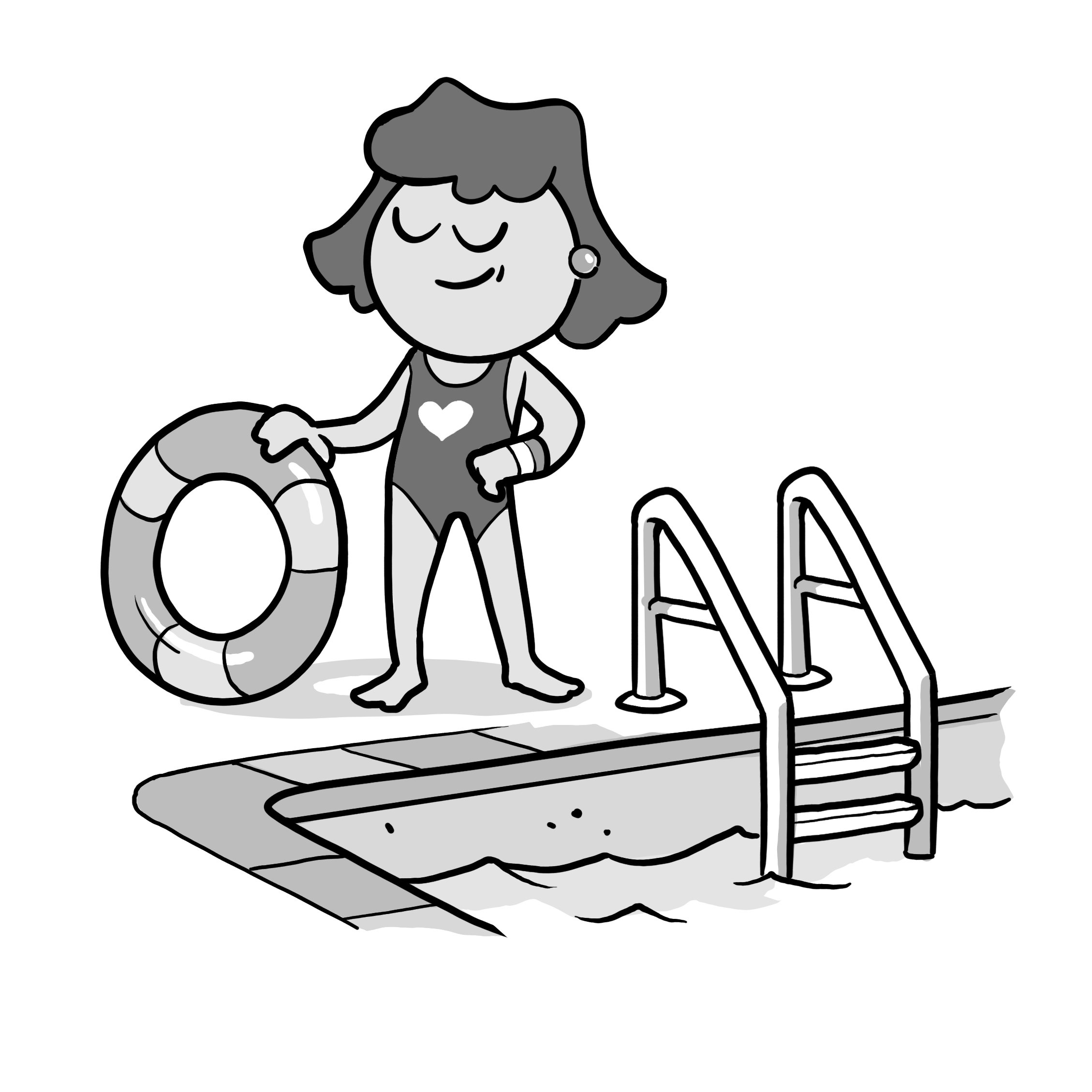The Benefits of Pool Therapy for Breast Cancer
Pool Therapy can Help with Breast Cancer; Move Easier, Decrease Pain and Feel Better.
Pool Therapy, otherwise known as hydrotherapy, aqua therapy or aquatic therapy can have many widespread benefits for all 5 phases of a breast cancer journey. Those with breast cancer often find pool therapy encouraging. Water is an environment where exercise can happen safely and easily, benefiting many breast cancer treatment related conditions.
The physics of water work in our favour. The pressure of the water known as ‘hydrostatic pressure’ acts like a global brace, supporting all the joints of the body. Imagine one big brace if you will, helping all your joints to feel safe! In addition, water provides buoyancy. This translates into less gravitational impact, and less load on the body. Water can free up movement, resulting in less pain.
Patients with breast cancer often undergo a mastectomy and/or breast reconstruction in addition to radiation. These treatments can result in a stiffening of the shoulder. Adhering to a post-surgical or post-radiation pool therapy plan can help to better manage pain and stiffness.
Post-surgery or Post-radiation? Pool Therapy can Help.
Effective breast cancer treatment requires a personalized approach, often including the consideration of breast cancer genetics and personalized medicine in treatment and rehab. Hence pool therapy prescription and rehab planning need to be personalized as well to assure safety and efficacy. The general benefits of pool therapy are evident for all cancers; within breast cancer the benefits remain far reaching. Let’s unpack a bit more.
Pool Therapy Improves the Mobility of the Shoulder and Thoracic Spine.
The buoyancy of water reduces the impact on the body, which can lead to less pain with movement. Pool therapy can allow patients to move easier and further than on land. Adhering to a rehab plan for shoulder mobility in the water can allow muscles to stretch and nerves to guide, promoting circulation and reducing the chance of neuropathies (chemotherapy induced peripheral neuropathies a side).
Mastectomy and breast reconstruction surgeries often impact the pec musculature. Often the arm is held close to the body for a few weeks, while the wound heals. This can lead to upper back stiffness and pec tightening. In the pool, once the wound has fully sealed typically after ~ 4 weeks post-op, chest opening, thoracic extension and lengthening of the pec musculature are easily supported.
Post Surgery or Post Radiation? Pool Therapy can Benefit Shoulder Range of Motion.
Breast cancer related radiation treatments such as radiation can also impact the pec musculature, shoulder mobility and upper back in a similar way to mastectomies or reconstructive surgery. Radiation fibrosis syndrome (RFS) is an umbrella term to encompass adverse reactions to radiation; it is a diagnosable cancer treatment related condition. In breast cancer, RFS can present as abnormal stiffening of the shoulder, breathlessness or pain in the thorax, shoulder or chest wall.
If the skin integrity allows, pool therapy post radiation can be an effective way to decrease pain and promote range of motion in the shoulder and thoracic spine. Adhering to a pool therapy program can help to decrease pain associated with RFS and other breast cancer treatment conditions.
Pool Therapy Decreases Pain.
As discussed above buoyancy is a wonderful thing as is hydrostatic pressure. When your brain feels that all your joints are supported in addition to your joints receiving less impact, together these experiences often allow your brain to relax a little. This leads to your pain response being less protective, meaning less pain results. When less pain occurs, it becomes easier to make exercise a habit. When pain arises after mastectomy reconstructive surgery, movement can feel limiting and pool therapy can help.
At times breast cancer conditions may develop such as post-mastectomy pain syndrome, adhesive capsulitis, or chording; the associated symptoms can be highly irritable. Pool therapy can be the first ‘safe place’ where your brain finally allows your thoracic spine, arms and shoulders to move with some ease.
Water can Help Joints Feel Safe, Leading to Less Pain
Pool Therapy Improves Muscle Endurance and Stamina.
As gravity takes less of toll in the water, this means you can move with more ease, and perhaps even faster. When you increase the pace of any task, your heart rate and blood pressure respond. This is known as endurance training, doing a repetitive movement with light load.
Water allows you to stress your aerobic system, there for increasing your aerobic capacity resulting in exercise as medicine. This results in improved stamina, the ability to handle stuff. When considering a return-to-work post breast cancer, evidently stamina matters. If you’re struggling with cancer related pain, or other breast cancer related conditions when exercising on land, consider pool therapy as your first place to start rebuilding stamina.
Muscle endurance vs strength, how do we distinguish the two? Building strength requires progressive overload and gravity. This is the one down fall of aquatic therapy, the pool does not promote significant gains in strength bone density or balance. Pool therapy is simply not conducive for rebuilding bone density or muscle mass, whose loss can be a side effect of hormone therapy. Strength and bone density gains occur best moving on land coupled with a safe and clinical approach to exercise.
However, the pool can allow for repetitions of light movements, which can improve muscle endurance. These adaptations all lead to improved tolerance of walking, improved posture, and better standing endurance. Improved stamina and muscle endurance can lead to the confidence to start a gradual return to work plan.
Pool Therapy can Help Muscles act like Pumps, Decreasing Swelling.
Pool Therapy Reduces Swelling.
Pool therapy involves hydrostatic pressure as mentioned above. This global brace on your body can act like a compressive force, reducing edema/swelling. In addition, gentle movements in the pool can elevate your heart rate, improving your circulation. Muscles act like pumps starting to move fluid better, returning blood flow to the heart. Pool therapy and movement can result in persistent swelling getting re-absorbed. The increased movement of stubborn fluid can activate lymphatic drainage around the chest wall and shoulder, helping to better manage lymphedema and general edema.
Pool Therapy Improves Cardiovascular Health.
This should be of no surprise! We spoke above about muscular endurance and stamina benefiting from pool therapy. As your aerobic system is heavily driven by your cardiovascular system, your heart’s fitness and lung capacity therefor greatly benefit from you getting into the pool!
Some medications such as Trastuzumab or Herceptin, may have a cardio-toxic effect impacting your exercise tolerance. Most patients will have regular ECG’s to monitor their heart health and left ejection fraction rate while on these medications. It’s important to understand how to exercise safely while taking these medications; prescribed pool therapy program may be a healthy option for you.
Bone Metastasis can be very Painful, Pool Therapy Can Help.
Pool Therapy Can Help with Bone Metastasis.
Bone Metastasis for example is a cancer related condition that can cause land-based exercises to be very limited in addition to being very painful. Pool therapy is an incredibly safe approach to starting cancer rehab when diagnosed with bone mets. Often patients find the pool to be the first place they have experienced pain relief, as we can decompress the spine through buoyancy. In addition, water reduces impact on joints. Reduced load promotes moving with ease; and in the case of bone metastasis, pool therapy can help preserve function, reduce falls and improve your quality of life.
Pool therapy rehab plans vary immensely in intensity and the type of exercises prescribed. Before starting any pool therapy program, consider an initial cancer rehab assessment where your health history, diagnosis and exercise prescription details will be accounted for.
Everyone’s breast cancer journey is their own. If you feel the need for more support to build capacity in your body, consider consulting with a cancer physiotherapist and getting started with pool therapy today.
Thank you for your interest in science and rehab,
Kindly, The Cancer Physio








